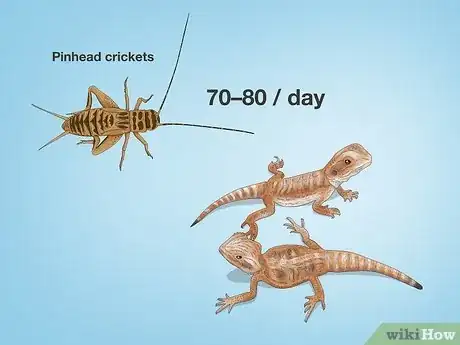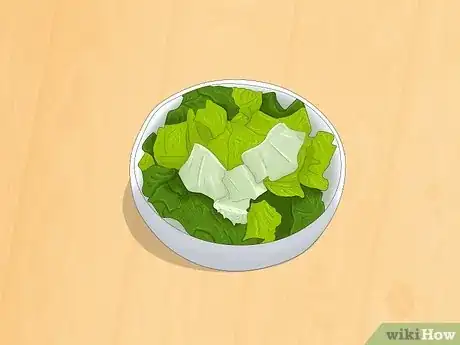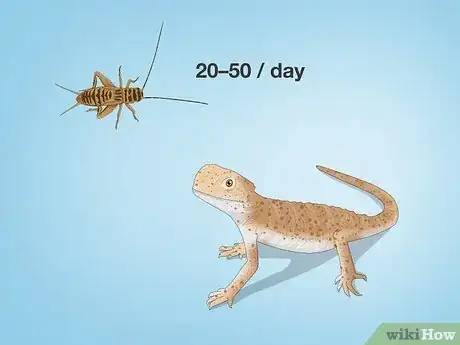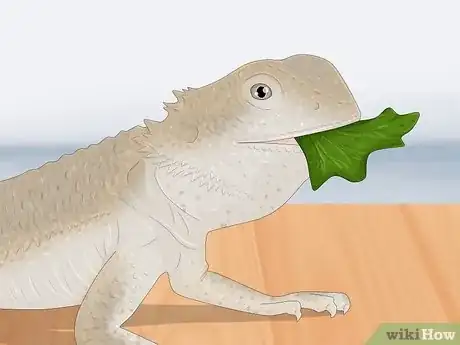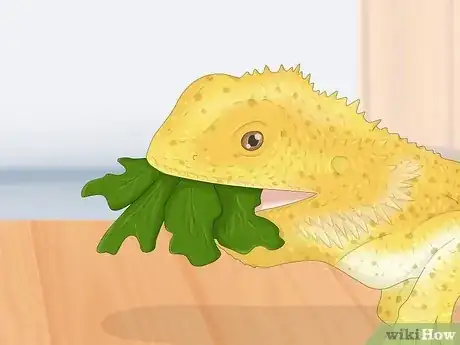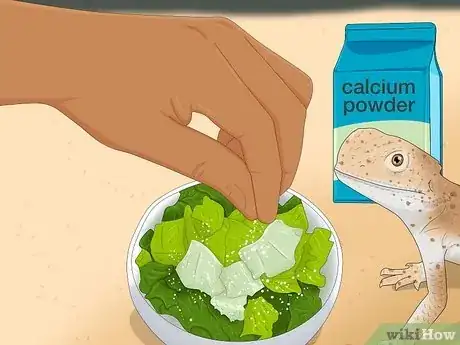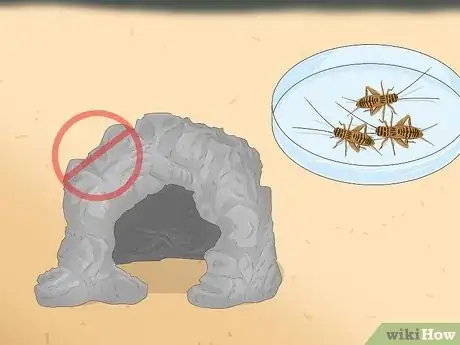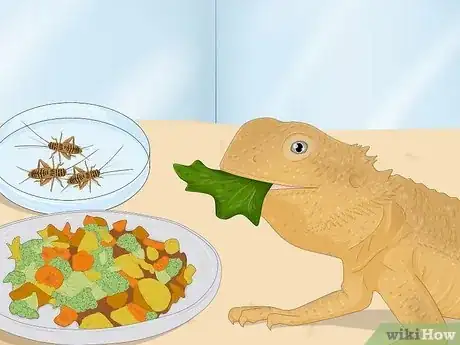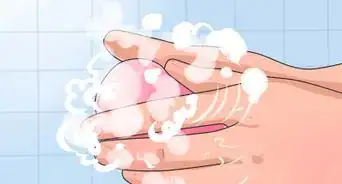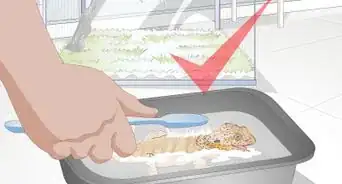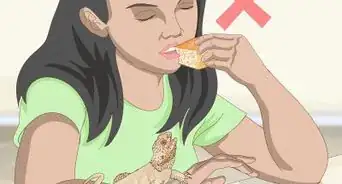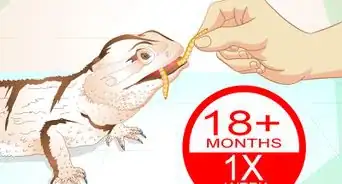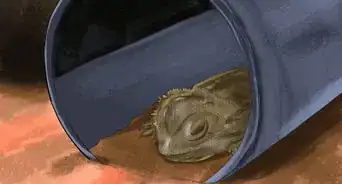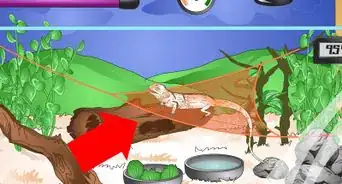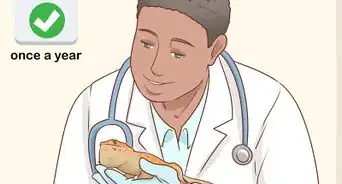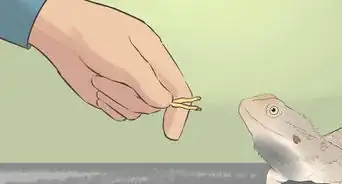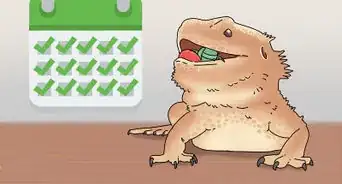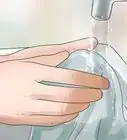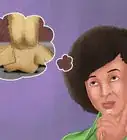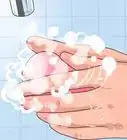This article was co-authored by wikiHow staff writer, Hunter Rising. Hunter Rising is a wikiHow Staff Writer based in Los Angeles. He has more than three years of experience writing for and working with wikiHow. Hunter holds a BFA in Entertainment Design from the University of Wisconsin - Stout and a Minor in English Writing.
There are 12 references cited in this article, which can be found at the bottom of the page.
Learn more...
It’s time to feed your newly hatched bearded dragon, but how do you know if you’ve given them enough crickets? These insects are an important part of your bearded dragon’s meal, but the amount they should eat changes as they grow older. Luckily, we’ve covered everything you need to know about feeding your beardie. Keep reading to learn how many crickets your bearded dragon needs to have a healthy and balanced diet.
Things You Should Know
- Give a baby bearded dragon about 70–80 crickets each day split between 4–5 feedings.
- Feed juvenile beardies 20–50 crickets daily over 2–3 feedings.
- Give an adult bearded dragon only 10 crickets a day.
- Supplement your bearded dragon’s diet with dark leafy greens and chopped vegetables.
Steps
How many crickets should a baby bearded dragon eat?
-
1Give a baby beardie up to 70–80 crickets per day. Use live pinhead crickets that are about 1⁄8–1⁄4 in (3.2–6.4 mm) long.[1] Split the crickets between 4–5 feedings each day. Let your baby beardie eat as many crickets as they want during the feeding time so they develop muscles and more body mass.[2]
- Bearded dragons are considered babies for about 5 months after they hatch.
- Avoid giving bearded dragons crickets that have grown larger than the space between their eyes. Otherwise, the insects could get stuck in your beardie’s digestive system.
-
2Offer vegetables during each feeding. Give your bearded dragon a small food bowl filled with some finely chopped dark leafy greens, like collard greens, dandelion, mustard greens, or turnip greens. Include some diced or shredded squash, peas, sweet potato, zucchini, or beans for some added flavor.[3]
- Leave the vegetables in your beardie’s tank throughout the day and remove them at night.
- The amount of vegetables your beardie eats will vary as they get older. When they’re a baby, your bearded dragon will eat more crickets than veggies. Once they start growing bigger and older, they’ll focus more on eating the vegetables.
- You don’t need to use every vegetable during each feeding. Occasionally mix up what ingredients you use to take care of your bearded dragon.
Feeding Routine
-
1Dust any food items with calcium powder. Use the calcium powder both on crickets and vegetables. Just take a pinch of the powder and sprinkle it directly on top of the food to cover it. That way, your bearded dragon gets even more nutrients that it needs to grow strong.[8]
- Alternatively, put the crickets or vegetables in a small bag or container with the powder, and shake them around until they’re evenly coated.
- Once every 2 weeks, sprinkle a multivitamin powder onto the food instead.
-
2Remove any hiding spots from your beardie’s enclosure. It’s easier for your bearded dragon to hunt crickets if the insects don’t have places to hide. Clear out the bottom of your beardie’s tank as much as you can so it’s easier for them to hunt.[9]
- Alternatively, put the crickets in a container that’s too tall for them to jump out from, but short enough for your bearded dragon to climb into.
-
3Place the food in your bearded dragon’s tank. Feed your bearded dragon at least 1 hour after you turn on their basking light for the day. Set the dish with fruits and veggies in the bottom of the tank and pour in 5–10 crickets at a time. If a baby or juvenile bearded dragon eats all crickets, then add in a few more to keep feeding them.[10]
-
4Take out uneaten crickets after 10–15 minutes. Scoop out any crickets that are leftover so your bearded dragon doesn’t overeat. Save the crickets to use them during the next feeding.[11]
- Avoid leaving dead crickets in your bearded dragon’s tank since they could make your pet sick once they start decomposing.
- Don’t forget to set up the tank again when you’re finished feeding.
Warnings
- Avoid feeding your beardie wild-caught insects since they could have traces of insecticide that harm your pet.[14]⧼thumbs_response⧽
References
- ↑ https://www.bgsu.edu/content/dam/BGSU/college-of-arts-and-sciences/biological-sciences/Herpetarium-documents/Lizards/new_inland_central_bearded_dragon_caresheet.pdf
- ↑ https://www.beardeddragoncare101.com/wp-content/pdfs/bdc101-caresheet.pdf
- ↑ https://lafeber.com/vet/wp-content/uploads/Bearded-Dragons.pdf
- ↑ https://timberlinefresh.com/Timberline/assets/File/WhoEatsWhat_2016.pdf
- ↑ https://www.beardeddragoncare101.com/wp-content/pdfs/bdc101-caresheet.pdf
- ↑ https://youtu.be/-Bvf4j9H3Oo?t=529
- ↑ https://lafeber.com/vet/wp-content/uploads/Bearded-Dragons.pdf
- ↑ https://www.bbpetstop.com/wp-content/uploads/2014/04/HO-bearded-dragon.pdf
- ↑ https://carolinadesignerdragons.com/wp-content/uploads/2018/06/Taking_Care_of_-Your-Bearded-Dragon_062118.pdf
- ↑ https://carolinadesignerdragons.com/wp-content/uploads/2018/06/Taking_Care_of_-Your-Bearded-Dragon_062118.pdf
- ↑ https://www.bgsu.edu/content/dam/BGSU/college-of-arts-and-sciences/biological-sciences/Herpetarium-documents/Lizards/new-rankins-dragon-caresheet.pdf
- ↑ https://espace.library.uq.edu.au/view/UQ:229678
- ↑ https://www.bbpetstop.com/wp-content/uploads/2014/04/HO-bearded-dragon.pdf
- ↑ https://www.bbpetstop.com/wp-content/uploads/2014/04/HO-bearded-dragon.pdf
